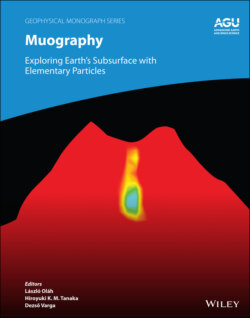Читать книгу Muography - Группа авторов - Страница 14
1.1 INTRODUCTION
ОглавлениеMany geodynamical activities on Earth are driven by movements of geofluids, i.e., any subsurface fluid, such as magmatic fluid, groundwater, petroleum, etc., that passes through subsurface porous media. In many cases in geophysical studies, it is important to identify such geofluid motions as well as the properties of these porous media, which serve as the pathways of these fluids. Muography, the technique of using high‐energy (relativistic) muons as a radiographic probe, can be used to image the internal structure of hectometric to kilometric‐scale objects. The term muography means “muon rendering” in ancient Greek. While photography utilizes photons (the word for “light” in ancient Greek), muography utilizes the characteristics of relativistic muons. Muography can be explained by using the analogy of medical imaging. One example is medical radiography, in which X‐ray transmission through the human body clarifies the shape and state of internal organs based on differences in thickness or density; for example, bones are easily differentiated from skin tissue. The muon, also indicated by the Greek letter μ, is a charged lepton, which is free from strong force interaction but sensitive to electromagnetic force. Therefore, high‐energy muons can be easily detected, but they have a stronger penetration power than X‐rays. Muons can therefore be used to create similar shadows inside objects with much larger proportions than the human body.
These high‐energy muons are produced continuously via the interactions of galactic cosmic‐ray (GCR) particles with the upper atmosphere of the Earth. Muography is perhaps the only technology that harnesses energy originated from outside of the solar system. Muography is a technique that doesn’t require active energy sources to transmit probing signals, and thus it is power‐efficient and almost maintenance free. Therefore, it is a cost‐effective technique, in particular for the purpose of long‐time‐range monitoring.
Since GCRs also arrive at other planets, comets, and asteroids, in principle, muography can be conducted on these celestial objects. Under the conditions of the extraterrestrial environments, muons are generated either in the atmosphere or within the planet itself, depending on the existence and thickness of the atmosphere. As a consequence, the resultant energy spectra vary among stellar bodies and thus, the size of the objects that can be imaged also depends on the type of stellar body to be studied. The purpose of this chapter is to provide a clear understanding of the advantages, disadvantages, and characteristic properties of muography. The layout of this chapter is as follows. In Section 1.2, we review the principles of muography. The general features of the muographic probe including the energy spectra on the Earth, Mars, and asteroids (Section 1.2.1), geomagnetic effect (Section 1.2.2), altitude effect (Section 1.2.3), time‐dependent variations (Section 1.2.4), the general concept of muography including energy‐range relationship in terms of muon flux reduction after passing through matter (Section 1.2.5), scattering by the target volume (Section 1.2.6), measurement background (Section 1.2.7), required measurement times (Section 1.2.8), muographically averaged thickness (Section 1.2.9), and limitations of muography and potential geological targets (Section 1.2.10) are discussed. In Section 1.3, after the brief introduction of early works in Section 1.3.1, we discuss the results of measurements in pioneering works by addressing two major topics: subsurface volcanism and tectonics (Sections 1.3.2, 1.3.3, and 1.3.4) and underground water (Section 1.3.5) and conclusions are given in Section 1.4. Various kinds of detectors used for muography will be introduced in the following chapters, and thus will not be described here.
